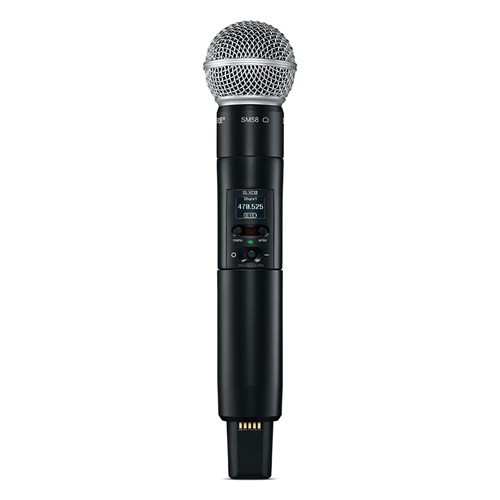Ever wondered how wireless microphone systems work? These audio solutions are a fantastic upgrade for any stage show, enhancing mobility and amplifying your event while reducing clutter and maintaining a streamline – sleek professional look. Our spotlight on sound covers a basic approach of how wireless microphones work, to broaden your understanding of these audio systems, such as the Shure SLX-D Wireless Handheld SM58 Microphone.

Basic Components of a wireless microphone systems:
A wireless microphone system primarily consists of two parts: the transmitter and the receiver. Event elevating tech solutions makes us proud – we love what we do – so we thought we’d share a little for for anyone looking into microphone hire or equipment rentals.

- Transmitter: The microphone picks up the audio signal and sends it to the transmitter. The transmitter then processes this audio signal using ultra-high frequency (UHF) modulation and sends it through the air. This is where the magic of wireless microphone technology begins.
- Receiver: The receiver is listening out for the transmitted signal – catches it – and converts it back to the original audio signal. This audio can then be played back in real-time through a PA sound systems, providing seamless and clear audio.
Understanding Frequency
When it comes to frequency, wireless systems typically offer several selectable groups, each containing multiple channels which are scanned and logged automatically by the devices. The frequencies of these channels are pre-calculated to minimise interference, making it easier for you to set up and use. Our team handles all of this with the use of wireless workbench and equipment such as the Shure SLX-D Wireless Lapel Microphone.
More advanced systems provide additional groups and channels, which is beneficial for larger venues. They also allow for manual frequency adjustment via software, which is important for larger and more complex setups. We provide professional service to handle even the most intricate audio visual setups as frequency band space and traffic differs from state to state.
The Technical Process in a nutshell
The fundamental principle of a wireless system is converting the audio signal from the microphone into a radio signal. This signal is then transmitted over the air to the receiver, which converts it back into an audio signal for the PA system hire. The signal, which is the radio frequency, is modulated by the audio signal. This modulation allows the receiver to listen the original audio. This is similar to how a car radio works. This process is called “frequency modulation” or FM in short. FM is used in many applications to do with sound and it’s an integral part of the technical process of wireless technologies. With advancements in audio visual technology, using modern wireless microphone systems is easier than ever!
At LIDA AV, we specialise in providing quality wireless microphone systems for all your events in Melbourne. Whether you’re planning a corporate event or setting up for a school musical, our tailored tech solutions ensures that you get the best audio visual technology available with quality techs who are there to help!

For all your microphone hire and equipment rental needs, LIDA AV offers friendly quality expertise and professional service with an easy going attitude. Contact us today to learn more about our wireless microphone systems and how we can enhance your next event.
Frequently Asked Questions (FAQ)
1. What are the main components of a wireless microphone system?
A wireless microphone system typically includes a transmitter (built into the microphone or bodypack) and a receiver. The transmitter converts audio into a radio signal, while the receiver captures that signal and converts it back into audio for the PA system.
2. How do wireless microphones transmit sound without cables?
Wireless microphones use ultra-high frequency (UHF) modulation to convert audio into radio waves. These waves are sent through the air to a receiver, which decodes the signal and delivers it in real time to the sound system.
3. Why is frequency selection important in wireless microphone systems?
Frequencies must be carefully chosen to avoid interference from other devices. Modern systems scan available frequencies and automatically select the best channels, while advanced setups allow manual adjustments for larger or more complex venues.
4. What is the role of frequency modulation (FM) in wireless microphones?
Frequency modulation (FM) is the process of embedding the audio signal onto a radio frequency. The receiver then demodulates this signal, restoring it to the original audio. This method ensures clear, stable transmission with minimal distortion.
5. When should I use a professional AV team for wireless microphone setups?
Professional AV teams ensure seamless operation by handling frequency coordination, interference management, and technical setup. For larger venues, corporate events, or performances, experts like LIDA AV guarantee reliable, high-quality sound.
